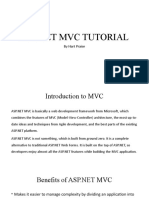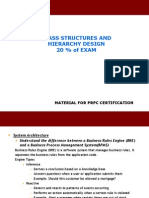0 ratings0% found this document useful (0 votes)
58 viewsWeb2py Mapping Urls
Web2py Mapping Urls
Uploaded by
alaa abu madiControllers are Python modules that define functions (actions) to handle requests. Actions process data and prepare it for views. Views are templates that define the response structure. When a URL is requested, Web2py maps it to a controller, action, and view. The action processes data and passes it to the view, which generates the response. This separation of concerns allows flexibility and modularity.
Copyright:
© All Rights Reserved
Available Formats
Download as PPTX, PDF, TXT or read online from Scribd
Web2py Mapping Urls
Web2py Mapping Urls
Uploaded by
alaa abu madi0 ratings0% found this document useful (0 votes)
58 views10 pagesControllers are Python modules that define functions (actions) to handle requests. Actions process data and prepare it for views. Views are templates that define the response structure. When a URL is requested, Web2py maps it to a controller, action, and view. The action processes data and passes it to the view, which generates the response. This separation of concerns allows flexibility and modularity.
Copyright
© © All Rights Reserved
Available Formats
PPTX, PDF, TXT or read online from Scribd
Share this document
Did you find this document useful?
Is this content inappropriate?
Controllers are Python modules that define functions (actions) to handle requests. Actions process data and prepare it for views. Views are templates that define the response structure. When a URL is requested, Web2py maps it to a controller, action, and view. The action processes data and passes it to the view, which generates the response. This separation of concerns allows flexibility and modularity.
Copyright:
© All Rights Reserved
Available Formats
Download as PPTX, PDF, TXT or read online from Scribd
Download as pptx, pdf, or txt
0 ratings0% found this document useful (0 votes)
58 views10 pagesWeb2py Mapping Urls
Web2py Mapping Urls
Uploaded by
alaa abu madiControllers are Python modules that define functions (actions) to handle requests. Actions process data and prepare it for views. Views are templates that define the response structure. When a URL is requested, Web2py maps it to a controller, action, and view. The action processes data and passes it to the view, which generates the response. This separation of concerns allows flexibility and modularity.
Copyright:
© All Rights Reserved
Available Formats
Download as PPTX, PDF, TXT or read online from Scribd
Download as pptx, pdf, or txt
You are on page 1of 10
Web2py
Controllers, actions, and views
Controllers, actions, and views
• In Web2py, controllers, actions, and views work together to handle
requests and generate responses for web applications.
• Controllers are Python modules that define functions to handle requests.
Each function in a controller is called an action, and it typically performs
some data processing and prepares data to be displayed in a view.
• Actions are functions that receive and return parameters. When a user
requests a URL, Web2py maps the URL to a specific controller and
action, and the action is executed.
• Once the action has processed any necessary data, it is prepared to be
displayed in a view.
Controllers, actions, and views
• Views are HTML templates that define the structure and layout of the
response. Views can include placeholders for data that is dynamically
generated by the controller or action.
• In Web2py, views can be written using different templating languages,
such as HTML, CSS, and JavaScript, and can be customized for
different devices and user interfaces.
Separation of Concerns
• The separation of concerns between controllers, actions, and views
allows for greater flexibility and modularity in web application
development.
• Changes can be made to individual components without affecting the
rest of the application, making it easier to maintain and update code.
Mapping URLs
• By default, Web2py maps simple URL requests to a controller, action,
and view based on the URL path.
• For example, a request for http://localhost:8000/myapp/default/index
is mapped to the default.py controller, index action, and
default/index.html view.
• The default mapping mechanism is case-insensitive for controller,
action, and view names.
Mapping URLs
• If a requested controller, action, or view is not found, Web2py raises
an HTTP 404 error.
• Web2py has a default controller and action that are used when a URL
path is not specified.
• By default, the default.py controller and index action are used for such
requests.
• The default mapping mechanism in Web2py is designed to make it
easy for developers to build simple web applications quickly, while
still providing the flexibility to customize the mapping for more
complex scenarios.
controllers, actions, and views interaction
1.A user requests a URL, such as /myapp/default/index.
2.Web2py maps the URL to the default.py controller and the index
action.
3.The index action retrieves data from a database or other data source
and prepares it to be displayed in the view.
4.The prepared data is passed to a view, such as default/index.html,
which defines the HTML structure and layout of the response.
5.The view renders the response, including any dynamically generated
data, and returns it to the user's browser.
Example
• Controller (default.py): which contains
• Action (index function):
• This action sets a variable name to the string 'Web2py'.
• It returns a dictionary containing name as a key and its value as the value.
Example
• View (default/index.html):
Example
How does it work:
• The controller has a single action named index.
• The index action sets the variable name to the string 'Web2py'.
• It then returns a dictionary with the key name and its value.
• The view default/index.html uses {{=name}} to access the value of the
name variable and include it in the HTML response.
• When the user visits the URL (localhost:8080//myapp/default/index) that
maps to this controller and action, Web2py will execute the index action,
prepare the data, and render the view with the dynamically generated data.
You might also like
- Gero - Exam 1 Study GuideDocument75 pagesGero - Exam 1 Study GuideTravis Hartsgrove100% (4)
- Bauer BG 24 H: Rotary Drilling RigDocument24 pagesBauer BG 24 H: Rotary Drilling Rigbudhi rakitan100% (1)
- Codeigniter PDFDocument18 pagesCodeigniter PDFInfinity GBNo ratings yet
- Oracle Business Intelligence Enterprise Edition 12c - Second EditionFrom EverandOracle Business Intelligence Enterprise Edition 12c - Second EditionNo ratings yet
- Adeept Ultimate Starter Kit For RPi ManualDocument103 pagesAdeept Ultimate Starter Kit For RPi ManualJagadeesh Venugopal100% (1)
- Physics 1 Honors Formula SheetDocument11 pagesPhysics 1 Honors Formula SheetCody JohnsonNo ratings yet
- MAD 1 - Week 5 Parampreet SinghDocument12 pagesMAD 1 - Week 5 Parampreet SinghashfourallNo ratings yet
- Unit 4Document47 pagesUnit 4lastminprep2022No ratings yet
- Model View ControllerDocument11 pagesModel View ControllerAjith Kumar RsNo ratings yet
- 01 YII2 IntroDocument41 pages01 YII2 Introantoniocanada98No ratings yet
- All Qa-1Document136 pagesAll Qa-1SHAILESH JORENo ratings yet
- CoreDocument41 pagesCoreanuragNo ratings yet
- Amit Kumar Singh ItbrainshapersDocument54 pagesAmit Kumar Singh ItbrainshapersJean-yves LapicqueNo ratings yet
- Fullstack Development (Sharath Vtu)Document15 pagesFullstack Development (Sharath Vtu)ajithkumarbme2025No ratings yet
- DBMS Final ReportDocument5 pagesDBMS Final ReportShaniRulzzNo ratings yet
- Getting Started With MVC 5 and Visual Studio 2013: @trobbinsDocument40 pagesGetting Started With MVC 5 and Visual Studio 2013: @trobbinsSanele MbokaziNo ratings yet
- MVC IntroductionDocument49 pagesMVC IntroductionselenophileNo ratings yet
- Unit 10 ServletDocument49 pagesUnit 10 Servletlamkaramesh435No ratings yet
- ReactDocument8 pagesReactArsalan AhmedNo ratings yet
- CodeIgniterUserGuide1 7 2Document291 pagesCodeIgniterUserGuide1 7 2mayureshbandNo ratings yet
- Django Workshop 2013.06.22Document78 pagesDjango Workshop 2013.06.22Eric Chua100% (1)
- Net 1Document39 pagesNet 1saumitra ghogaleNo ratings yet
- Week 2 Lecture 3 TheoryDocument24 pagesWeek 2 Lecture 3 TheoryH.M. Jayed Chowdhury RabbyNo ratings yet
- Informatica Powercenter 8.6: Basics Training CourseDocument197 pagesInformatica Powercenter 8.6: Basics Training CourseLuis CybergatoNo ratings yet
- ASPDocument11 pagesASPńazli AhmedNo ratings yet
- IoT U-VDocument65 pagesIoT U-VVardhan TvkNo ratings yet
- Ms PressDocument8 pagesMs Pressapi-3833730No ratings yet
- Konsep MVCDocument19 pagesKonsep MVCSetiya NugrohoNo ratings yet
- J2EE Design Patterns: Sharath Sahadevan August 8, 2002 ST Louis Java SIGDocument35 pagesJ2EE Design Patterns: Sharath Sahadevan August 8, 2002 ST Louis Java SIGrajaishereNo ratings yet
- Spring MVC Pattern With Dispatcher ServletDocument3 pagesSpring MVC Pattern With Dispatcher Servletbansodesangam23No ratings yet
- MongoDB MongoosessDocument31 pagesMongoDB MongoosesskkkNo ratings yet
- Kindertonics IIDocument22 pagesKindertonics IIshireenNo ratings yet
- YiiDocument31 pagesYiiVaibhav PednekarNo ratings yet
- REST API Using Express - Coding NinjasDocument16 pagesREST API Using Express - Coding NinjasafshithafiNo ratings yet
- Yii 1Document18 pagesYii 1Ephraim BhaskarNo ratings yet
- J2EE Architecture OverviewDocument33 pagesJ2EE Architecture OverviewNguyen Xuan NghiemNo ratings yet
- Complete Reference To Informatica PDFDocument52 pagesComplete Reference To Informatica PDFpankaj311983100% (3)
- Full Stack Web DevelopmentDocument31 pagesFull Stack Web DevelopmentDevika DakhoreNo ratings yet
- Asp .Net MVCDocument114 pagesAsp .Net MVCFernando Torrez100% (4)
- URL Mapping & Friendly URLs Leue 20090303Document54 pagesURL Mapping & Friendly URLs Leue 20090303asukittaNo ratings yet
- Unit -V (React)Document83 pagesUnit -V (React)Jaya PrakashNo ratings yet
- Prepered .Net NewDocument9 pagesPrepered .Net NewsivaranjaniNo ratings yet
- Web2py IntroDocument9 pagesWeb2py Introalaa abu madiNo ratings yet
- The Working of Codeigniter Application Is Mentioned in A Simple Flowchart Given BelowDocument91 pagesThe Working of Codeigniter Application Is Mentioned in A Simple Flowchart Given BelowManagement AccountingNo ratings yet
- MVC TutorialDocument21 pagesMVC TutorialStephen Folarin OladunniNo ratings yet
- In This Session - We'll Look OnDocument11 pagesIn This Session - We'll Look Onsourabhkarn6262No ratings yet
- ADF TrainingDocument42 pagesADF TrainingdeepaksatiecNo ratings yet
- Struts: Submitted By: Deepti BhardwajDocument11 pagesStruts: Submitted By: Deepti BhardwajKannan KumarNo ratings yet
- DjangoDocument35 pagesDjangoamit10521202021No ratings yet
- Final Spring Boot DocumentationDocument37 pagesFinal Spring Boot DocumentationArtiNo ratings yet
- BODI Training v1.1Document87 pagesBODI Training v1.1Kishorenaga AppariNo ratings yet
- Siebel OPENUI Technical OverviewDocument16 pagesSiebel OPENUI Technical Overviewjoy4unj0% (1)
- R12 Building OA Framework Applications: Concepts of The MVC Design PatternDocument35 pagesR12 Building OA Framework Applications: Concepts of The MVC Design PatternKhaled-ASNo ratings yet
- Architectural Design and Evaluation of An Efficient Web-Crawling SystemDocument8 pagesArchitectural Design and Evaluation of An Efficient Web-Crawling SystemkhadafishahNo ratings yet
- React IntroDocument45 pagesReact Intronehatabassum4237No ratings yet
- Class Structures and Hierarchy Design 20 % of EXAM: Material For PRPC CertificationDocument38 pagesClass Structures and Hierarchy Design 20 % of EXAM: Material For PRPC CertificationRepalleJayaramNo ratings yet
- Overview of The J2EE Specification: Dave Landers BEA Systems, Inc. Accelerated Development CenterDocument43 pagesOverview of The J2EE Specification: Dave Landers BEA Systems, Inc. Accelerated Development Centerrathu_mca8943No ratings yet
- WordPress Web Application Development: Everyone it seems loves WordPress and this is your opportunity to take your existing design and development skills to the next stage. Learn in easy stages how to speedily build leading-edge web applications from scratch.From EverandWordPress Web Application Development: Everyone it seems loves WordPress and this is your opportunity to take your existing design and development skills to the next stage. Learn in easy stages how to speedily build leading-edge web applications from scratch.No ratings yet
- Applied Architecture Patterns on the Microsoft Platform Second EditionFrom EverandApplied Architecture Patterns on the Microsoft Platform Second EditionNo ratings yet
- PV Budgeted Cost of Work Scheduled (BCWS) 50% of Total Budget $1,000Document3 pagesPV Budgeted Cost of Work Scheduled (BCWS) 50% of Total Budget $1,000alaa abu madiNo ratings yet
- Team CharterDocument3 pagesTeam Charteralaa abu madiNo ratings yet
- Project Closure Report Version ControlDocument2 pagesProject Closure Report Version Controlalaa abu madiNo ratings yet
- Web2py IntroDocument9 pagesWeb2py Introalaa abu madiNo ratings yet
- Work Breakdown StructureDocument19 pagesWork Breakdown Structurealaa abu madiNo ratings yet
- ControllerDocument8 pagesControlleralaa abu madiNo ratings yet
- Project Charter and Scope StatementDocument2 pagesProject Charter and Scope Statementalaa abu madiNo ratings yet
- List Tuples Set DictDocument17 pagesList Tuples Set Dictalaa abu madiNo ratings yet
- HTMLFormsDocument9 pagesHTMLFormsalaa abu madiNo ratings yet
- Prepared By: Mohammed JabariDocument19 pagesPrepared By: Mohammed Jabarialaa abu madiNo ratings yet
- BootstrapDocument17 pagesBootstrapalaa abu madiNo ratings yet
- Azure DNSDocument2 pagesAzure DNSalaa abu madiNo ratings yet
- Chapter 15 AJAXDocument17 pagesChapter 15 AJAXalaa abu madiNo ratings yet
- Top ReviewerDocument16 pagesTop ReviewerangellthegraceeNo ratings yet
- Pulsar 180 Wiring DiagramDocument1 pagePulsar 180 Wiring DiagramDipankar Kapri0% (1)
- M3 MPL Physics (Basic Mathematics) TeachersDocument49 pagesM3 MPL Physics (Basic Mathematics) TeachersNirranjan JNo ratings yet
- Group Collaboration Contract Template 2Document3 pagesGroup Collaboration Contract Template 2Aaron OrogNo ratings yet
- Fact Sheets: Internationally Trained Workers: Access To The Engineering Profession in OntarioDocument14 pagesFact Sheets: Internationally Trained Workers: Access To The Engineering Profession in OntarioSanthu MeprathuNo ratings yet
- Session 7 - Shear Strength of SoilsDocument27 pagesSession 7 - Shear Strength of SoilsmohamedyahaiNo ratings yet
- Nuclear Energy Notes Form 1 PDFDocument3 pagesNuclear Energy Notes Form 1 PDFryanNo ratings yet
- Year 3 Literacy Homework ResourcesDocument8 pagesYear 3 Literacy Homework Resourcesafesbibdy100% (1)
- Business Plan Rubric PDFDocument9 pagesBusiness Plan Rubric PDFcerps_one100% (1)
- River Basin ProcessesDocument16 pagesRiver Basin Processes3alliumcourtNo ratings yet
- The Entrepreneurial Development in Baywalk (Albia Et Al)Document96 pagesThe Entrepreneurial Development in Baywalk (Albia Et Al)JAL KETH ABUEVA100% (1)
- Painting Workshop 3 - Piha Beach Seascape - Lesson Notes - Samuel Earp ArtistmrDocument1 pagePainting Workshop 3 - Piha Beach Seascape - Lesson Notes - Samuel Earp ArtistmrMohamed Abou El hassan100% (1)
- Sipmos Small-Signal Transistor: GS (TH)Document8 pagesSipmos Small-Signal Transistor: GS (TH)rolandseNo ratings yet
- Block: Orthodox Systems - 2Document4 pagesBlock: Orthodox Systems - 2Vidya DinakaranNo ratings yet
- Тема «Finance. Sources Of Finance» Word studyDocument10 pagesТема «Finance. Sources Of Finance» Word studyssdadasdNo ratings yet
- Amardeep Office ChairDocument37 pagesAmardeep Office ChairsONDY mONDYNo ratings yet
- UCS 5108 Blade Server Chassis Spec Sheet (May 2011, 20 Pages)Document20 pagesUCS 5108 Blade Server Chassis Spec Sheet (May 2011, 20 Pages)b1bsterNo ratings yet
- The Effects of College Student Employment On Academic AchievementDocument11 pagesThe Effects of College Student Employment On Academic AchievementCarla Flor LosiñadaNo ratings yet
- Biochemistry Notes DAB 3-TERM 3, 2021 (MARCH) Lesson Three Basic Biochemical Techniques Separation Technqiues (A) Cell FractionationDocument6 pagesBiochemistry Notes DAB 3-TERM 3, 2021 (MARCH) Lesson Three Basic Biochemical Techniques Separation Technqiues (A) Cell Fractionationjohn mwangiNo ratings yet
- ProjectDocument33 pagesProjectAbhishek SharmaNo ratings yet
- Naberthern CatalogueDocument52 pagesNaberthern CatalogueMarcoNo ratings yet
- Red Hat Enterprise Linux-6-Storage Administration Guide-En-USDocument224 pagesRed Hat Enterprise Linux-6-Storage Administration Guide-En-USPrasad NandamNo ratings yet
- File System Basics File Compression Archiving and BackupDocument9 pagesFile System Basics File Compression Archiving and BackupChristopher InclanNo ratings yet
- The Standard Sep05Document31 pagesThe Standard Sep05cgrachanenNo ratings yet
- Notification 102-IiDocument536 pagesNotification 102-IiShashank VermaNo ratings yet




































































































